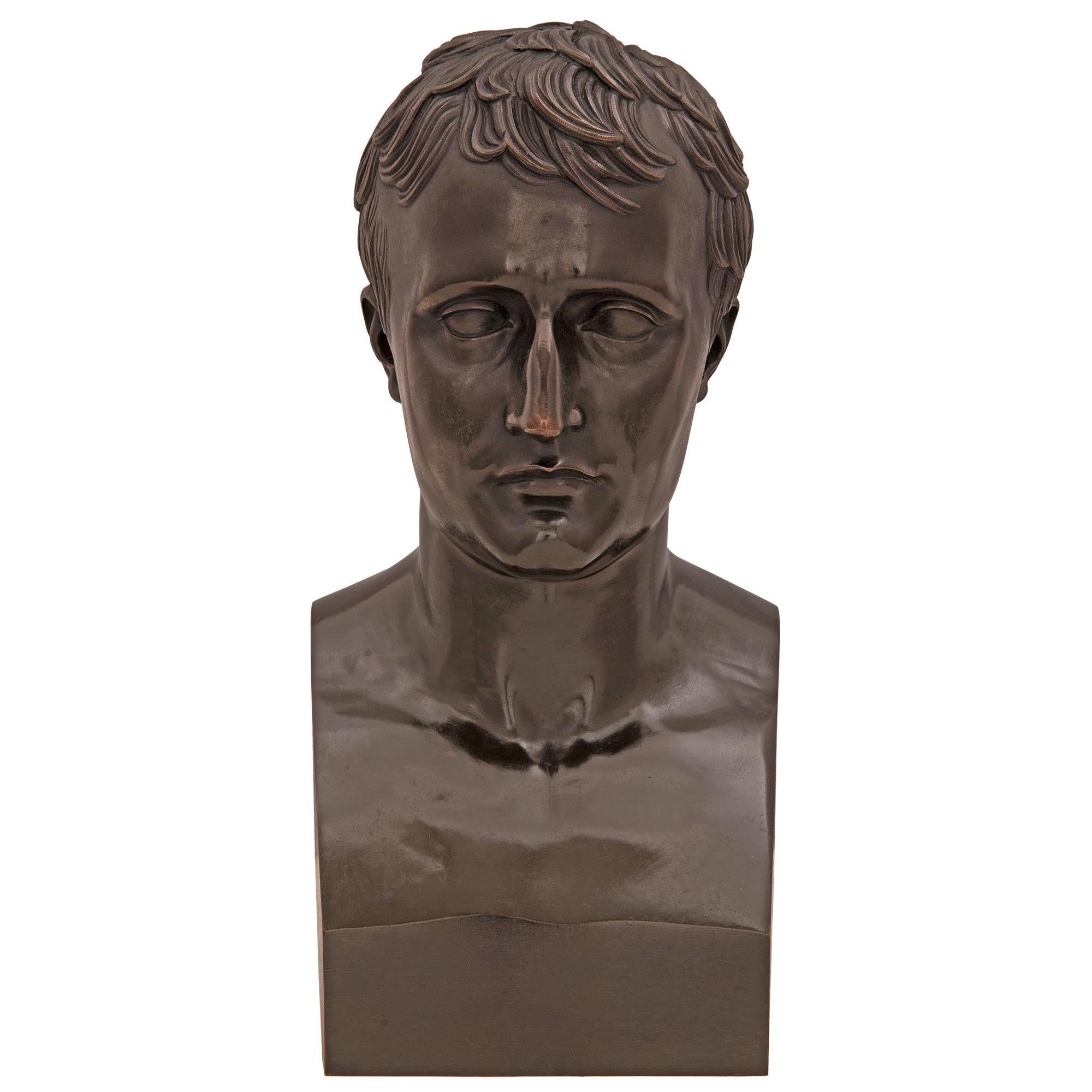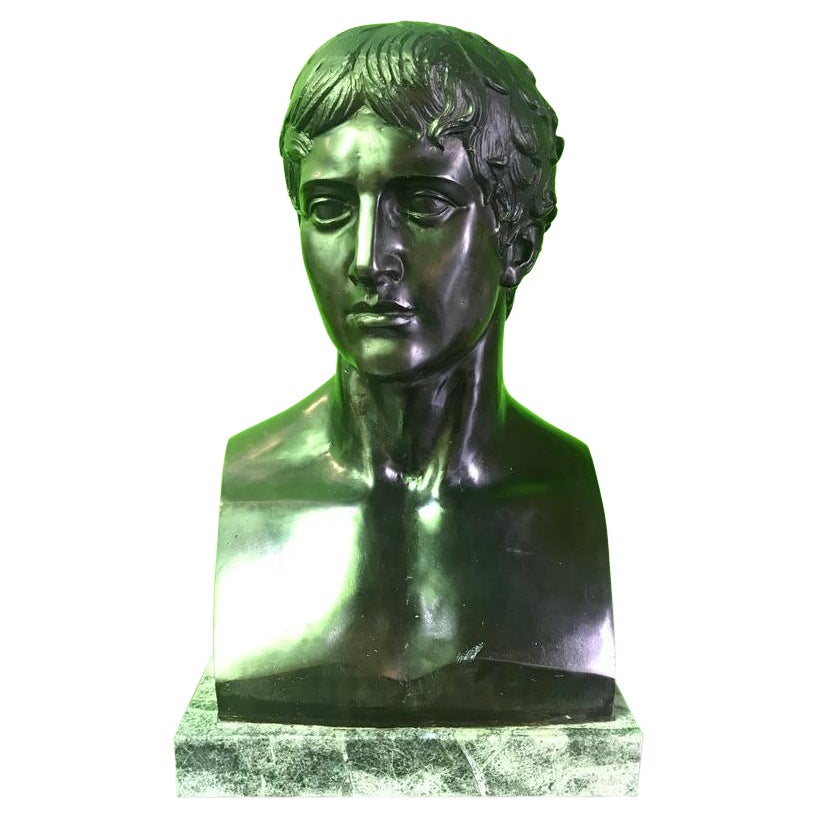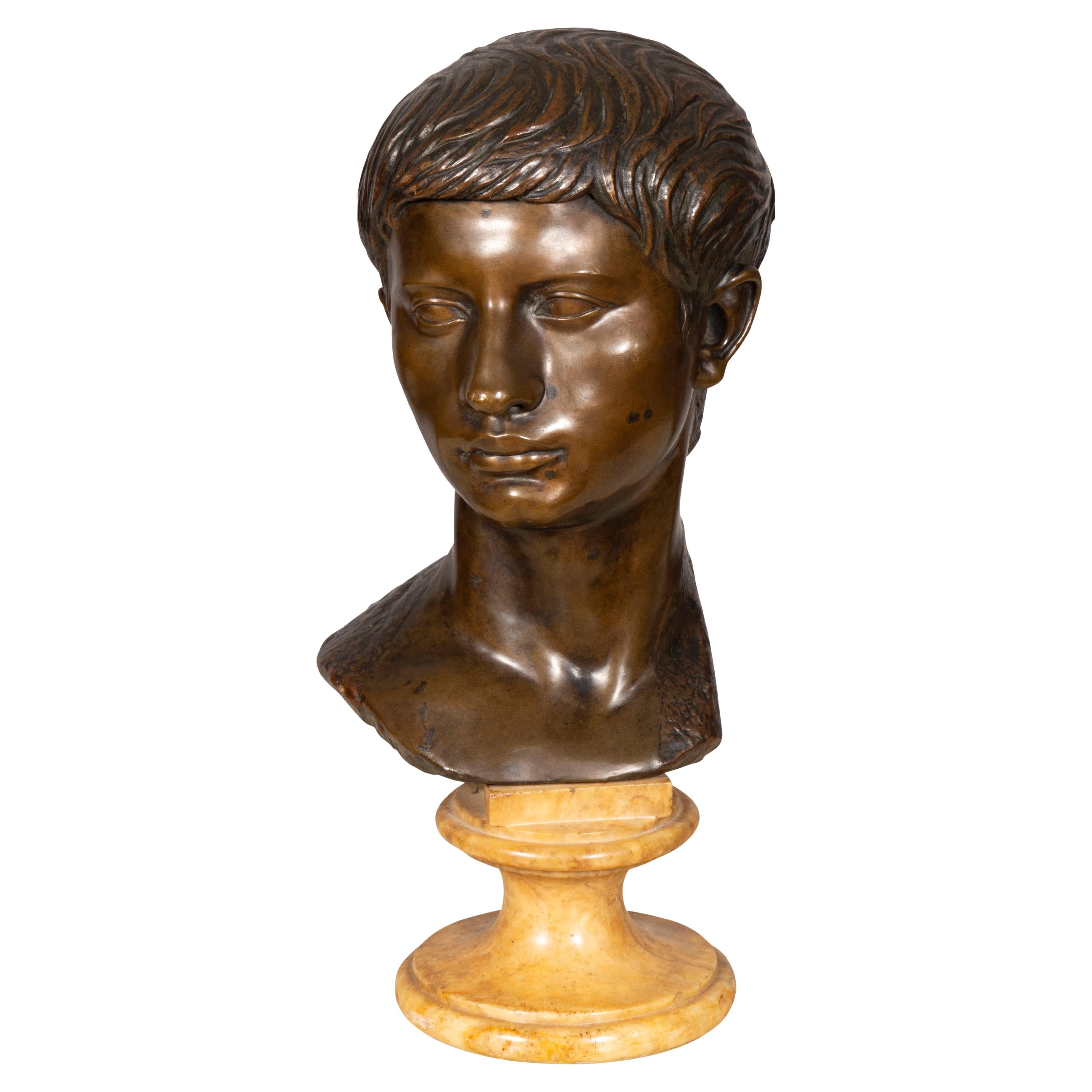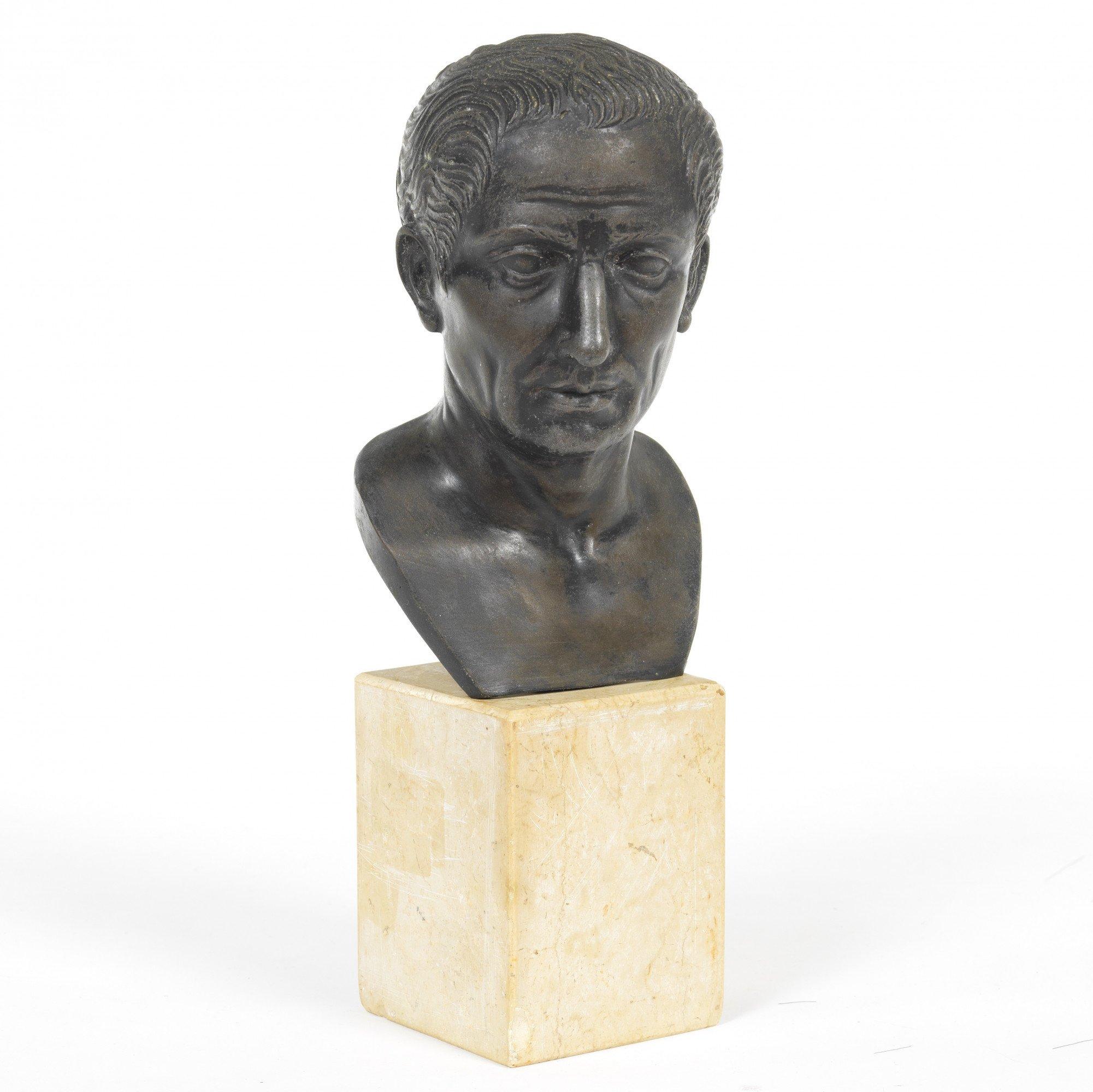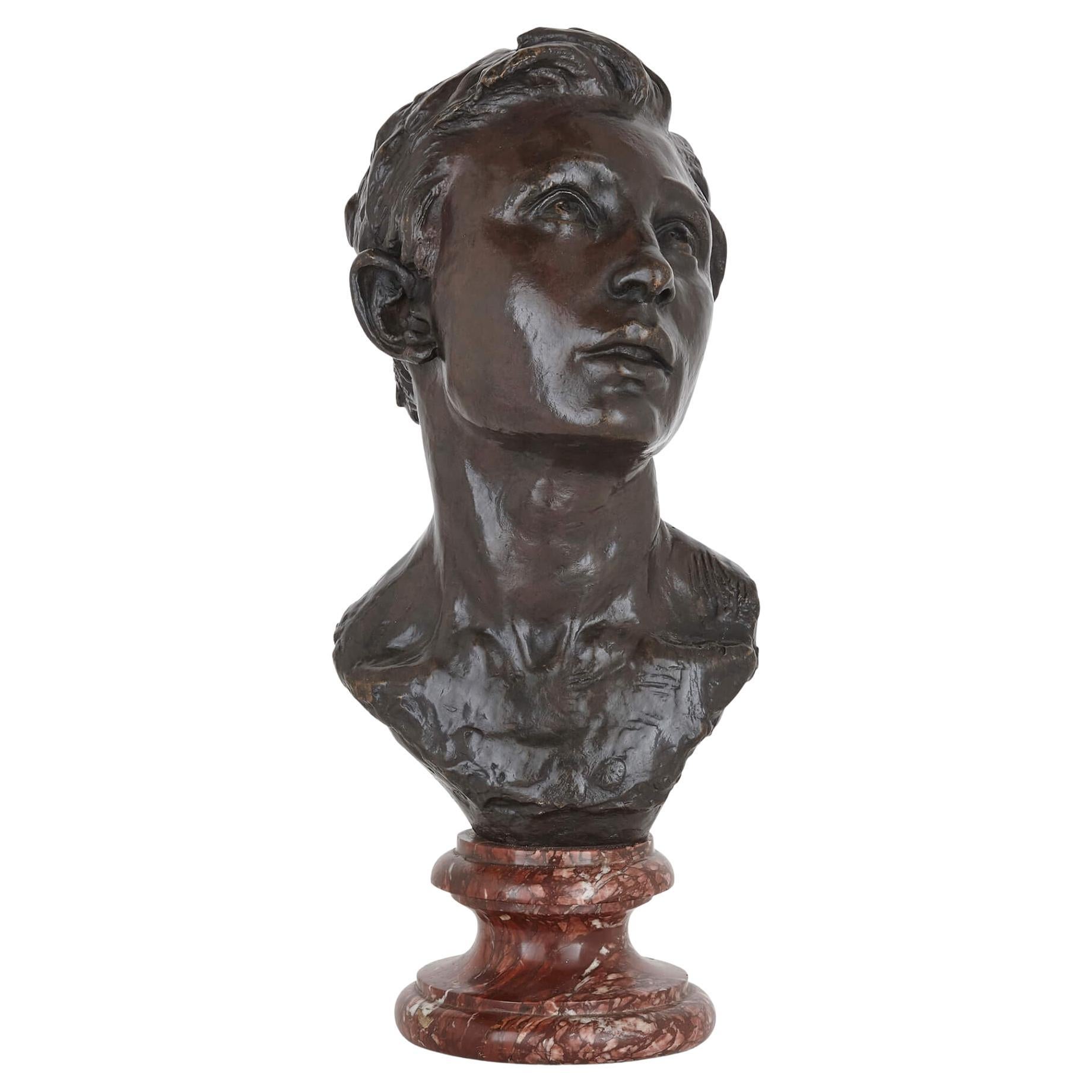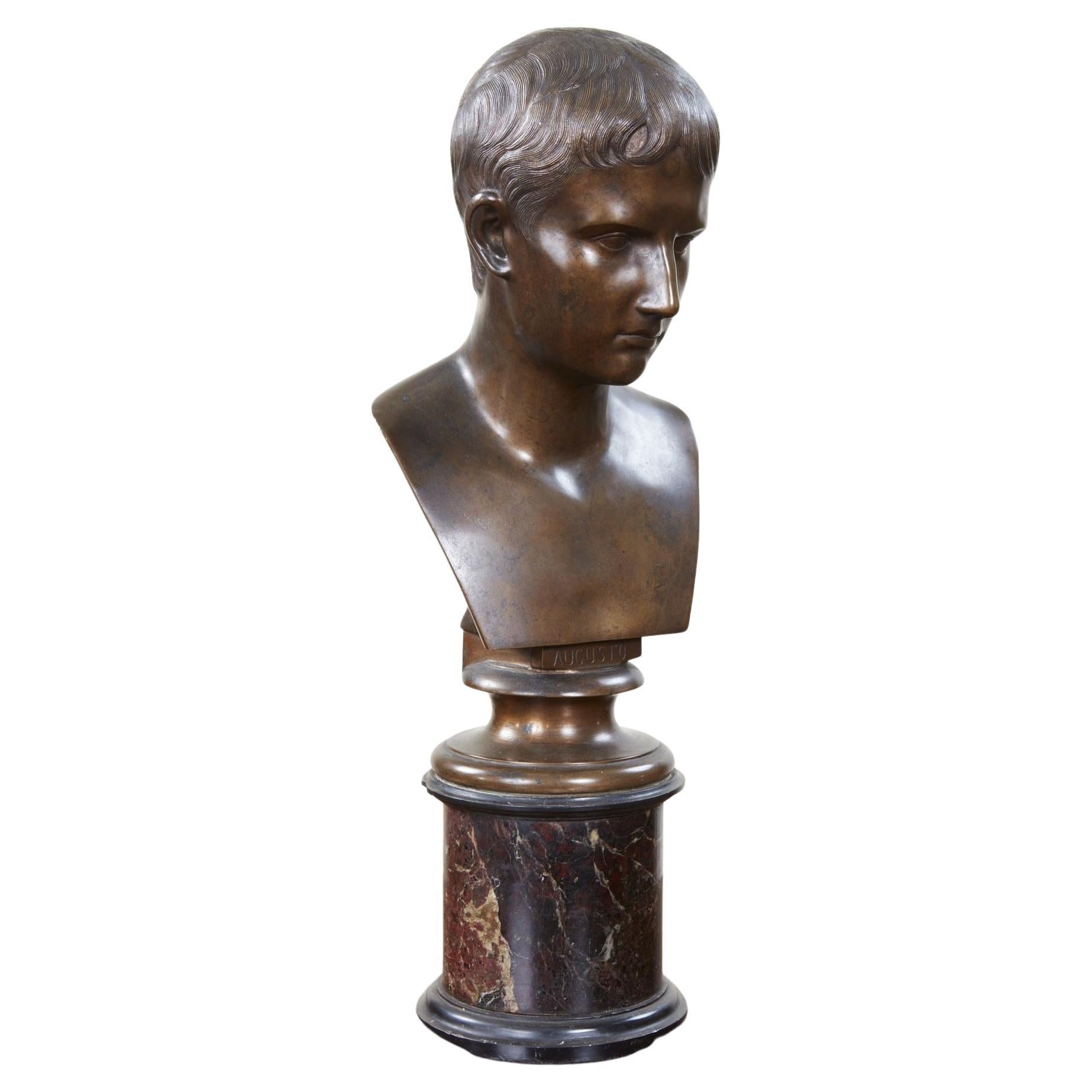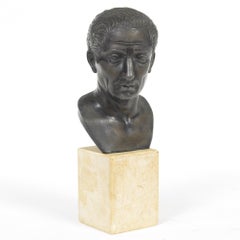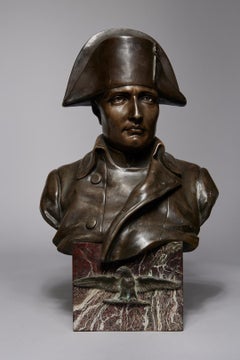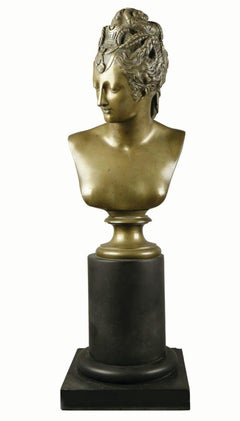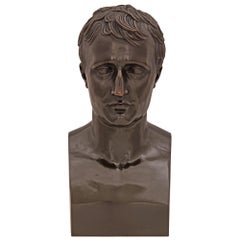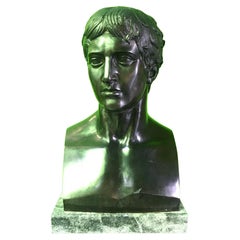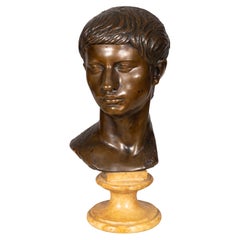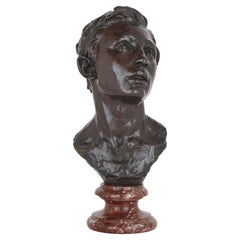Items Similar to 19th Century Bronze Bust of Young Napoleon as Caesar
Video Loading
Want more images or videos?
Request additional images or videos from the seller
1 of 11
19th Century Bronze Bust of Young Napoleon as Caesar19th Century
19th Century
$5,000
£3,773.36
€4,319.93
CA$7,051.66
A$7,741.84
CHF 4,038.93
MX$93,687.05
NOK 50,621.78
SEK 47,699.03
DKK 32,247.12
About the Item
After Antonio Canova (Italian, 1757-1822)
Bust of Young Napoleon as Caesar, 19th Century
Hallow cast bronze with verdigris patina, attached to rouge marble base
After one of a series of portraits produced by Canova between 1802 and 1822
Signed in bronze "CANOVA" on the side.
15 x 7 x 7 inches
Antonio Canova is considered the greatest Neoclassical sculptor of the late eighteenth and early nineteenth centuries. Along with the painter Jacques Louis David, he was credited with ushering in a new aesthetic of clear, regularized form and calm repose inspired by classical antiquities. He was also renowned for his carving abilities and the refinement of his marble surfaces, which seemed as supple as real flesh.
Canova was born in northern Italy in the small town of Possagno in 1757 to a family of sculptors and stonecutters, including his grandfather, Pasino Canova, and his father, Pietro. Nineteenth-century biographies of the artist, in a tradition dating back to the Renaissance, suggest Canova’s artistic talent revealed itself at an early age when, as a young child, he carved a lion made out of butter at a dinner party. Although this has been dismissed by scholars as apocryphal, by the age of fourteen, he was apprenticed to the sculptor Giuseppe Bernardi, who was based first in Pagnano, near Asolo, then Venice. After Bernardi’s death in 1774, Canova entered the studio of Bernardi’s nephew, Giovanni Ferrari. In Venice, Canova was heavily influenced by casts of ancient works that he saw, particularly those in the collection of Filippo Farsetti, for whom he completed his first independent work, Two Baskets of Fruit (1774; Museo Correr, Venice). Larger, freestanding figural works followed, including Eurydice and Orpheus, completed for Senator Giovanni Falier in 1775–77 (Museo Correr), and Daedalus and Icarus, 1778–79 (Museo Correr), for Procurator Pietro Pisani.
In 1779–80, Canova made the Grand Tour of Italy, where he saw the great collections of art in Bologna, Florence, Rome, and Naples, an experience he recorded in a travel diary. In 1781, he established his own studio in Rome, which had a thriving cultural and arts scene. Although Canova’s early works revealed the influence of Baroque theatrics in their dramatic subjects, agonized expressions, and twisting forms, in Rome he was influenced by antiquarians, archaeologists, and patrons who promoted a more restrained aesthetic. Theseus and the Minotaur (1782; Victoria and Albert Museum, London), his first major work in this new style, heralded the beginning of a Neoclassical aesthetic and established his reputation as one of the finest sculptors in Europe.
Throughout the 1780s and 1790s, Canova’s reputation continued to grow. He completed commissions in a wide variety of genres: funerary monuments, such as the papal monuments for Clement XIII (1783–92) and Clement XIV (1783–87) (49.116.78), religious subjects, portraits, and mythological deities and heroes inspired by classical antiquity. These latter works reaffirmed his reputation as the leading sculptor of the age. Triumphant Perseus, for instance, was clearly modeled on the Vatican’s Apollo Belvedere (49.97.114), a sculpture that was heralded as a highlight of the papal collection. When Canova’s sculpture was purchased by Pope Pius VII in 1801, it became the first modern work of art to enter the Vatican Collections. The next year, in recognition of Canova’s stature, Pius VII designated the artist Inspector General of the Fine Arts of the Papal States, a post that gave him authority over the Vatican museums and the export of works of art from Rome.
Despite the political turbulence of the period, including the French invasions of Italy and the establishment of the Napoleonic empire, Canova successfully continued to work for a wide range of patrons. These included Napoleon and the Bonaparte family, and his Bust of Napoleon (2015.489) was one of the most widely regarded and reproduced portraits of the emperor. Yet despite his acceptance of these commissions, Canova remained in Pope Pius VII’s favor as well; when Napoleon was deposed in 1815, it was Canova whom the Pope sent as a diplomatic attaché to Paris on behalf of the Papal States.
After the French Empire collapsed in 1815, travel and trade resumed in full force across the continent. The last seven years of Canova’s life were dominated by commissions from British patrons, who were drawn to the artist’s sinuous figures (1970.1), and by the design and construction of a church in his hometown of Possagno. The Tempio, as it is known, allowed Canova to showcase his skills not just as a sculptor, but also as a painter and architect. A cross between the Roman Pantheon and Athenian Parthenon, the church brought together classical architectural features in the celebration of Christ. Canova was also responsible for the design of the sculptural metopes on the exterior; unfortunately, he died in 1822 before those works were completed.
At his death, commemorations were held in Rome, Venice, and Possagno, and he was widely mourned and honored across Europe. The degree of his fame can be measured by the treatment of his corpse, as if it were a saintly relic. Although his body was entombed in the Tempio in Possagno, his hand was preserved at the Accademia di Belle Arti, Venice, and his heart placed in a tomb built by Neoclassical sculptors based on his own design in Santa Maria Gloriosa dei Frari (67.219.1).
Canova’s Studio and Posthumous Reputation
The degree of Canova’s fame and the breadth of his sculptural production can also be measured by the popularity of his studio in Rome, which became a “must-see” tourist destination. He had a large workshop with many assistants, common practice for sculptors who had many commissions, due to the lengthy and grueling process of working in marble. Canova was frequently present, modeling large clay models or carving marble, and travelers on the Grand Tour made it a regular stop in the hopes of seeing the artist or simply admiring his works. For those visitors who could not afford a Canova sculpture, there was no shortage of tourist souvenirs available in the city; many purchased small cast impressions of intaglios after Canova’s works that were available as sets from local vendors (1992.405.1–.35).
Visitors to the studio were introduced to the full range of Canova’s work, and the studio became a proto-museum of sorts. It also laid bare the many steps of sculptural production. These included the creation of small terracotta bozzetti, large clay models, a variety of plaster casts—both working models and ones after finished works—and, finally, the marble itself. The Metropolitan is fortunate to have one of Canova’s working casts, Cupid and Psyche (05.46), a preparatory model for the second version of the work; it is studded with metal pins, which assistants would have used to transfer the design to a marble block (130.8 C23). Keeping plaster casts like this on hand also allowed Canova and his assistants to make replicas of works for patrons; he could, moreover, continue to make modifications to the casts as his ideas about the work changed. Therefore, although sometimes he produced several versions of a work, he never copied himself directly. The Perseus with the Head of Medusa in the Met’s collection (67.110.1), for instance, was made for the Polish countess Valeria Tarnowski, who had seen Triumphant Perseus in the studio. The Met’s version, however, is not a mere copy of the first; in the second version, Canova grew more daring in his execution of the sculpture and eliminated the marble strut that supports Perseus’ outstretched arm in the Vatican’s version.
In the years following his death, Canova’s fame was so great that works that remained in his studio were completed and sent off to eager patrons (2003.21.2; 2003.21.1). A brisk trade in Canova works was complemented by the reproduction of his more lyrical designs in other decorative arts (26.267.85). A museum in Possagno, the Gipsoteca Canoviana, conceived and constructed by Canova’s half-brother, Giovanni Battista Sartori-Canova, in 1836, was opened in the artist’s memory and features a large collection of working casts that formerly had occupied the studio. Although Canova’s reputation suffered a decline in the late nineteenth and early twentieth centuries, it was revived by Italian scholarship in the 1950s, and today he has resumed his place as one of the most important sculptors in the history of art.
- Creation Year:19th Century
- Dimensions:Height: 15 in (38.1 cm)Width: 7 in (17.78 cm)Depth: 7 in (17.78 cm)
- Medium:
- After:Antonio Canova (1757 - 1822, Italian)
- Period:
- Condition:
- Gallery Location:Beachwood, OH
- Reference Number:1stDibs: LU1768215823982
About the Seller
5.0
Platinum Seller
Premium sellers with a 4.7+ rating and 24-hour response times
Established in 1975
1stDibs seller since 2022
39 sales on 1stDibs
Typical response time: <1 hour
- ShippingRetrieving quote...Shipping from: Beachwood, OH
- Return Policy
Authenticity Guarantee
In the unlikely event there’s an issue with an item’s authenticity, contact us within 1 year for a full refund. DetailsMoney-Back Guarantee
If your item is not as described, is damaged in transit, or does not arrive, contact us within 7 days for a full refund. Details24-Hour Cancellation
You have a 24-hour grace period in which to reconsider your purchase, with no questions asked.Vetted Professional Sellers
Our world-class sellers must adhere to strict standards for service and quality, maintaining the integrity of our listings.Price-Match Guarantee
If you find that a seller listed the same item for a lower price elsewhere, we’ll match it.Trusted Global Delivery
Our best-in-class carrier network provides specialized shipping options worldwide, including custom delivery.More From This Seller
View All19th Century Bronze Bust of Julius Caesar on Stone Base
Located in Beachwood, OH
Bronze Bust of Julius Caesar, 19th Century
Patinated bronze mounted to stone base
Unsigned
11.25 x 4.5 x 4.5 inches
Gaius Julius Caesar was a Roman general and statesman. A member o...
Category
19th Century Figurative Sculptures
Materials
Stone, Bronze
Late 19th Century Bronze Bust of Napoleon Sculpture, Italian Artist
Located in Beachwood, OH
Raphaël Nannini (Italian, 1852-1925)
Napoleon Bust, Late 19th Century
Bronze on marble base
Signed on back
17 x 11 x 8 inches
Raphael Nannini was born in Florence. He exhibited at t...
Category
Late 19th Century Figurative Sculptures
Materials
Marble, Bronze
Large Bronze Bust Sculpture of Diane de Poitiers, 18th Century
Located in Beachwood, OH
After Jean Goujon (French, 1510-1568)
Bust of Diane de Poitiers, 18th/19th Century
Bronze
14 x 7 x 5 inches
22 x 8 x 7 inches, with base
Diane de Poitiers was a French noblewoman and prominent courtier. She wielded much power and influence as King Henry II's royal mistress and adviser until his death. Her position increased her wealth and family's status. She was a major patron of French Renaissance architecture...
Category
Late 18th Century Figurative Sculptures
Materials
Bronze
18th Century French Terra Cotta Bust of a Young Gentleman
Located in Beachwood, OH
18th Century French Terra Cotta
Bust of a Young Gentleman
Terra Cotta
Unsigned
25 x 18 x 10 inches
41 lb.
Category
18th Century Figurative Sculptures
Materials
Terracotta
Bust of Diane de Poitiers, Bronze sculpture of French Noblewoman
Located in Beachwood, OH
After Jean Goujon (French, 1510-1568)
Bust of Diane de Poitiers
Bronze with gilt socle base
9 x 3.75 x 2.75 inches
Provenance: Removed from a private residence at the Pierre Hotel
Di...
Category
19th Century Figurative Sculptures
Materials
Bronze
Terracotta Bust of a Young Gentleman, Late 18th Century French Sculpture
Located in Beachwood, OH
After Philippe-Laurent Roland (French, 1746-1816)
Bust of a Young Man, 1772
Terra cotta set on painted wood pedestal
Signed and dated at back
16.5 x 11 x 8 inches
Philippe-Laurent R...
Category
1770s Figurative Sculptures
Materials
Terracotta
You May Also Like
French 19th Century Bronze Bust of Napoleon, after a Model by Antonio Canova
By Antonio Canova
Located in West Palm Beach, FL
A striking French 19th century patinated bronze bust of Napoleon, after a model by Antonio Canova. The bust is raised by a square base where the inscription Canova is displayed at th...
Category
Antique 19th Century French Busts
Materials
Bronze
Bronze Bust of Young Caesar
Located in Southall, GB
A superb quality bust of a young Julius Caesar. On a Verde Antico marble base.
Category
20th Century French Busts
Materials
Bronze
$2,757 Sale Price
20% Off
Italian Grand Tour Bronze Bust of Caesar
Located in Essex, MA
Bronze bust on yellow marble socle.
Category
Antique Late 19th Century Italian Grand Tour Busts
Materials
Marble, Bronze
French Bronze Sculpture Bust of a Man by Aimé-Jules Dalou
By Aimé-Jules Dalou
Located in London, GB
French bronze sculpture bust of a man by Aimé-Jules Dalou
French, 1888
Height 49cm, width 20cm, depth 21cm
This fine patinated bronze bust by the French s...
Category
Antique 1880s French Busts
Materials
Griotte Marble, Bronze
Grand Tour Bust of Augustus
Located in Greenwich, CT
Italian 19th century bronze bust of Augustus Ceasar, finely detailed and well patinated, standing on turned ebonized wood and marble socle plinth base.
Category
Antique Mid-19th Century Italian Grand Tour Busts
Materials
Marble, Bronze
Italian Grand Tour Antique Bronze Sculpture, Bust of Julius Caesar
Located in Shippensburg, PA
A finely cast and beautifully patinated bust of Julius Caesar, it likely originates from Rome circa the third quarter of the 19th century and rests over its original violet breché ma...
Category
Antique 19th Century Italian Grand Tour Busts
Materials
Marble, Bronze
More Ways To Browse
Marble Sculpture Early 19th Century
Antique Caesar
Antique Plaster Cast
Antique Medusa
19th Century French Bronze Sculpture Lion
Cupid Psyche
Pope Pius
Marble Busts Of Roman Emperors
Portrait Of Emperor
Bust Of Napoleon
Antonio Sculpture Bronze
Head Of Medusa
Carved Marble Figure Of Child
Caesar Bust
Sculpture Of Caesars
Roman Cross
Bronze Bust Of Roman Emperor
Apollo Belvedere Sculpture
